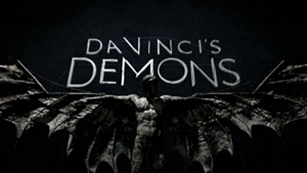
Catone in Utica is a 1728 opera by Leonardo Vinci. It was the original setting of Metastasio's libretto of that name.

Catone in Utica is a 1728 opera by Leonardo Vinci. It was the original setting of Metastasio's libretto of that name.

Leonardo di ser Piero da Vinci was an Italian polymath of the High Renaissance who was active as a painter, draughtsman, engineer, scientist, theorist, sculptor, and architect. While his fame initially rested on his achievements as a painter, he has also become known for his notebooks, in which he made drawings and notes on a variety of subjects, including anatomy, astronomy, botany, cartography, painting, and palaeontology. Leonardo is widely regarded to have been a genius who epitomised the Renaissance humanist ideal, and his collective works comprise a contribution to later generations of artists matched only by that of his younger contemporary Michelangelo.
Utica may refer to:

The Mona Lisa is a half-length portrait painting by Italian artist Leonardo da Vinci. Considered an archetypal masterpiece of the Italian Renaissance, it has been described as "the best known, the most visited, the most written about, the most sung about, [and] the most parodied work of art in the world". The painting's novel qualities include the subject's enigmatic expression, monumentality of the composition, the subtle modelling of forms, and the atmospheric illusionism.

The Last Supper is a mural painting by the Italian High Renaissance artist Leonardo da Vinci, dated to c. 1495–1498, housed in the refectory of the Convent of Santa Maria delle Grazie in Milan, Italy. The painting represents the scene of the Last Supper of Jesus with the Twelve Apostles, as it is told in the Gospel of John – specifically the moment after Jesus announces that one of his apostles will betray him. Its handling of space, mastery of perspective, treatment of motion and complex display of human emotion has made it one of the Western world's most recognizable paintings and among Leonardo's most celebrated works. Some commentators consider it pivotal in inaugurating the transition into what is now termed the High Renaissance.

Pietro Antonio Domenico Trapassi, better known by his pseudonym of Pietro Metastasio, was an Italian poet and librettist, considered the most important writer of opera seria libretti.

Leonardo Vinci was an Italian composer known chiefly for his 40 or so operas; comparatively little of his work in other genres survives. A central proponent of the Neapolitan School of opera, his influence on subsequent opera composers such as Johann Adolph Hasse and Giovanni Battista Pergolesi was considerable.

The Codex Leicester is a collection of scientific writings by Leonardo da Vinci. The codex is named after Thomas Coke, Earl of Leicester, who purchased it in 1717. The codex provides an insight into the mind of the Renaissance artist, scientist and thinker, as well as an exceptional illustration of the link between art and science and the creativity of the scientific process.
The year 1728 in music involved some significant events.

Gioacchino Conti, best known as Gizziello or Egizziello, was an Italian soprano castrato opera singer.

Artaserse is the name of a number of Italian operas, all based on a text by Metastasio. Artaserse is the Italian form of the name of the king Artaxerxes I of Persia.

Max Emanuel Cenčić is a Croatian countertenor. He was a member of the Vienna Boys' Choir.

Leonardo da Vinci High School is a high school temporarily housed on the east side of Buffalo, New York. There are 400 students enrolled in da Vinci spanning grades 9–12. The high school serves Grades 9 through 12. The current principal is Gregory Lodinsky.

Catone in Utica is an opera libretto by Metastasio, that was originally written for Leonardo Vinci's 1727 opera. Following Vinci's success, Metastasio's text was used by numerous composers of the baroque and classical eras for their own operas, including Pietro Torri (1736), Antonio Vivaldi (1737), Giovanni Battista Ferrandini (1753) and J. C. Bach (1761).

Da Vinci's Demons is a historical fantasy drama television series that presents a fictional account of Leonardo da Vinci's early life. The series was conceived by David S. Goyer and stars Tom Riley in the title role. It was developed and produced in collaboration with BBC Worldwide and was shot in Wales. The series has been distributed to over 120 countries.

Franco Maximiliano Fagioli is an Argentine operatic countertenor.

Domenico Giacinto Fontana (1692–1739), also known as "Farfallino", was an Italian castrato singer active primarily in Rome from 1712 to 1736. He specialised in singing soprano female roles and earned the name "Farfallino" for his graceful stage appearance. He was born in Perugia and died there at the age of 47. At times he feared ridicule by performing certain roles, such as a pregnant primadonna.
Celeste Gismondi, originally known as Celeste Resse and nicknamed La Celestina, was an Italian soprano opera singer, who performed a major role in the première of some works by George Frideric Handel, including Orlando.
Il Pomo d'Oro is a prize-winning orchestra founded in 2012 and named after the opera Il pomo d'oro by Antonio Cesti. The ensemble specialises in Historically informed performance of music from the Baroque and Classical period which it performs and records led by its own lead violinists Federico Guglielmo and Zefira Valova, or by guest conductors including Maxim Emelyanychev, Riccardo Minasi, Stefano Montanari, George Petrou, Enrico Onofri, Francesco Corti, Zefira Valova and the Stradella specialist Andrea De Carlo.

Catone is an Italian opera by George Frideric Handel. It is one of Handel's nine pasticcio works made up of music and arias by other composers than him. The opera was first performed at the King's Theatre, Haymarket, London, on 4 November 1732.